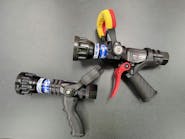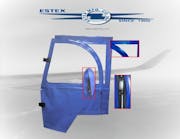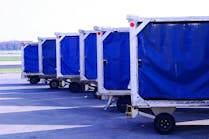To conduct timely and effective aircraft turnarounds, ground handling personnel require properly functioning equipment at the gate.
But when an operator’s conduct causes damage to the ground support equipment (GSE) in service, ground handlers lose efficiency. What’s more, the potential for danger increases. To combat this, manufacturers around the globe are developing solutions to prevent operator conduct from harming GSE.
“Equipment abuse increases maintenance and insurance costs as well as productivity losses for handlers, airports and airlines,” says Matthias Moulinier, product line manager at Adveez.
“Security and safety in the airport environment are paramount,” adds Arun Patel, CEO at Access Control Group, noting soft costs like equipment downtime, larger-than-required fleet sizes and higher workers’ compensation as a result of damaged equipment impacts the bottom line. “Frequent turnover of employees and lack of adequate training can cause injuries, equipment damage and – in some cases – aircraft damage.”
Common examples of abuse seen by Patel include unauthorized or untrained operators accessing GSE; avoidable damage to equipment, facilities and aircraft; personnel injuries; and larger repair costs, often due to ignoring warning signs such as overheating, low fluids, etc.
As a result, higher breakdown maintenance costs; a lack of available equipment; disruptions in flight schedules; higher insurance costs; and lower employee morale due to lack of accountability can occur.
Rod Gray, director and vice president of ground power at AERO Specialties, adds that a lack of periodical maintenance can exacerbate operator abuse. Without regular inspection, damage caused by collisions and other incidents can deteriorate and become a danger and a liability.
“Tow-bars regularly get bent; GPU cables regularly get run over, pulled and dragged; lavatory hoses get dragged or kinked and connections are constantly damaged,” Gray points out. “Water carts rarely get cleaned correctly and filters replaced. Ground power units and tractors do not get serviced as they should.
“These are all expensive acquisitions and will fail without the correct periodical maintenance.”
As a transmission supplier and a driveline solutions provider, officials at Powertrain Control Solutions (PCS) typically focus on abuse to the drivetrain of motorized assets.
“Areas of abuse that we are involved in is typically when a vehicle comes to a stop, the operators – unlike your car that you drive every day – they don’t typically come to a complete stop using the service brake and then shift into neutral and then apply the parking brake and then step out,” says Dan Boucher, president at PCS. “Typically, before the vehicle comes to a stop, they apply the parking brake or they apply reverse or something that shocks the driveline into coming to a stop, and then they hop off.”
Boucher says many operators do not appreciate how shifting before coming to a complete stop – even at a slow speed – can cause significant damage.
“What they don’t realize is, because of the gearing, the output shaft of the transmission is spinning like you were going 30 mph,” he says. “You would never apply the parking brake when going 30 mph, or shift into reverse when you’re going 30 mph.
“If you don’t have abuse protection built into the transmission, it will damage the transmission.”
Garcia Sanz, commercial manager of aviation services at Undagrid, notes additional operator abuse can include cornering harshly or braking late, putting undue duress on parts such as tires, tow-bars and brakes. Excessive idling of motorized GSE leads to additional fuel consumption and maintenance needs as well.
Abuse of equipment often provokes more abuse, warns Sanz, and accidents are more likely to happen with abused equipment.
These types of accidents can negatively affect the commercial position and the reputation of the ground handling agent, according to Sanz.
Moulinier adds vandalism, tinkering with equipment out of boredom or unprofessional activities like speeding present ground handlers with the risk of injuries and even fatal accidents.
Safety Through Components
In an ideal world, every ground service provider would operate equipment while following all guidelines and safety procedures. Realistically, however, improper usage – whether intentional or unintentional – takes place on the ramp.
To reduce the amount of damage incurred by improper use, manufacturers are producing abuse prevention technology.
At AERO Specialties, for example, the company provides a warning system on its JetGo GPUs that alerts users if a cable or connector is stored incorrectly before the unit’s tow-bar can be lowered. Additionally, tow-bars come equipped with an elastomer material to provide cushioning during towing.
“Our patented SiPsHitch tow force monitoring device can be fitted to any traditional tow tractor and will prevent the overstress of tow equipment and aircraft NLG,” Gray says. “This device will also teach the operator to be more careful during towing missions, which will in turn protect the equipment from damage.
“For safe towing, SiPsHitch will actively measure the towing forces and display these to the operator during the towing mission,” he continues. “The device will also act upon the power of the tractor and reduce power if the system reaches a predetermined force that could damage the equipment and aircraft.”
Both visible and audible alarms will function when too much stress is detected and a recording of the event is initiated for retrieval of data. The operator can also be locked out of further towing until an inspection and safe release by a supervisor has been performed.
Immediate benefits, he explains, are reduced equipment downtime, less personnel hazards and less inconvenience to customers and dispatch.
“Long-term benefits will be directly noticed on the financial reports of the company,” Gray says. “Accidents or incidents on the ramp are extremely costly to an operator both in the short-term as well as long-term.”
In regard to transmissions, Boucher says PCS focuses on three main areas to reduce GSE abuse.
The first is the transmission itself, which includes a patented valve body design.
“What that does is it will only allow the transmission to shift into forward or reverse when it’s safe to do so,” Boucher says. “So, you can’t neutral drop it. If you’re moving forward, you can’t shift into the opposite direction.
“Without that, the operator would be able to damage the transmission.”
PCS also introduced a shifter to the GSE market. When an abuse condition is happening, this shift lever locks into the position it is in, so the operator cannot cause damage.
An electric parking brake module also prevents abuse because a control module has been designed to prevent damage when engaging or releasing the brake. For example, if an operator tries to drive the equipment with the parking brake engaged, it will release the park brake before any damage occurs.
“They can be used independently,” Boucher says of PCS’ three-pronged approach to abuse prevention. “If you do use them together, you have this triangle of safety where each module is working independently to ensure the safe operation of the vehicle. It gives you a layer of redundancy because any one module can stop the vehicle from operating in an unsafe condition. But they’re also watching each other.
“So, you really get this layered approach to prevent abuse, but also enhance the safety of the vehicle.”
In the short-term, vehicles remain running and parts costs are reduced. Long-term, Boucher says users can start to implement strategies around safety incidents or develop a bigger picture of how a vehicle needs to operate.
“You get another level of safety by having these independent systems monitoring the vehicle because you can add in sensors,” he notes, adding the use of a transmission control module allows for customization to fit a specific operation.
Electronic sensors and telematics solutions are becoming increasing more prevalent in GSE.
“Telematics designed for the GSE environment can make a significant reduction in equipment abuse and related costs,” says Patel of Access Control Group. “Safety compliance coupled with safety training can also make a huge difference in how the GSE is operated.”
“By means of sensors, it is possible to establish impact of equipment with other objects – who is or has been using the equipment, whether it has been used in accordance with applicable instructions, how much fuel is consumed, if it is due for maintenance, etc.,” adds Undagrid’s Sanz. “Required or scheduled maintenance is further supported by the fact that a unit can conveniently be found in the operational field when sensors include the possibility to establish location.”
Patel points out Access Control Group's solutions utilize both impact monitoring sensors and gyro to measure turn angles.
“If the operators have a collision or take sharp turns, which may be deemed unsafe, our telematics system Vital or Advanced will record those events with date/time stamps, location and operator ID,” he says.
“Since the system is cloud-connected, alarms and alerts will be sent to our cloud platform AssetPro 360 immediately,” Patel adds. “AssetPro 360 can seamlessly integrate with an organization's preexisting maintenance software to provide enterprise-wide visability. Depending on preference, an email or text message can be sent to the desired personnel for timely action. Optionally, the equipment can be locked down to prevent further damage.”
In addition to preventing abuse, telematics also adds a sense of accountability.
“When operators scan their badge or enter a PIN, they leave a ‘fingerprint.’ Once they know anything that happens to the equipment during their log-in period is linked to their records, 70-80 percent of operators will change their behavior,” Patel says. “The ones who don’t can be coached, trained or disciplined as each incident is linked to the operator.”
Additional benefits of sensors and telematics, notes Sanz, includes equipment availability and timely turnarounds; safety for staff, equipment and infrastructure; reduction of non-scheduled inspection/maintenance; reduction in fuel consumption; and reduction of cost of short-term rentals.
With driver accountability in place, longer term benefits could mean behavioral change of operators regarding equipment and overall procedures, in general. Plus, overall efficiency, profitability and reputation can also improve.
Adveez also makes use of Internet of Things (IoT) technology as a tool to prevent abuse and follow-up on equipment usages and driver behaviors, Moulinier explains.
Adveez offers a hands-free access control device, that provides real-time data on the person driving a piece of equipment.
“It will monitor all its operations and usage during working hours, empowering the driver with its equipment,” Moulinier says.
Adveez’s FAMA device provides real-time GSE data, including when the equipment is started, the speed, idle time, fuel consumption, trajectory and driver ID on the airport apron.
Adveez also provides a device that can be activated via geofence from a web platform.
“We are particularly proud of our automatic speed control system that is automatically reducing the speed in certain areas or even around the aircraft during operations, which makes it safer for everyone,” Moulinier says, adding company officials have worked with a customer to make sure the system is sabotage proof and cannot be disabled.
Best Practices for Safe GSE
Prevention abuse components can be part of ongoing best practices for operating equipment on the ramp.
Moulinier of Adveez encourages users to take advantage of the real-time data provided by telematic solutions.
“By analyzing the data, many insights can be outlined and help extend the GSE life,” he says. “Thanks to proactive alerts and better operation efficiency, maintenance predictions are systematic, which helps extend the life of the equipment.”
AERO Specialties’ Gray agrees, stressing the importance of periodical maintenance to enhance the operation of GSE.
“Additionally, store the equipment inside a hangar and out of the weather as much as possible,” he points out, adding material selection like corrosion-resistant metals can also improve the life of GSE. “Regular operator training will also substantially reduce equipment damage and increase safety.”
Additional best practices to extend the life of GSE include ensuring proper safety compliance; eliminating equipment idling to comply with air quality standards; and taking full ownership of telematics solutions, Access Control Group's Patel advises.
“Telematics is a tool which, when coupled with best practices, can help GSE owners slash their total cost of ownership, as well as extend equipment lifespan,” he explains.
Electronic components and telematics also provide the ability to capture equipment diagnostics and fault codes.
Boucher of PCS encourages GSE maintenance personnel to expand preventative maintenance programs to include the use of a diagnostic tool to query for trouble codes.
“There are some codes that will get set and then they will get stored away, but they aren’t active that minute and it’s not turning on a warning light. But most of these modules are smart enough to detect the beginning of a problem, and the technician could make a note of those and maybe try to research it a bit better,” Boucher says.
He says this step could prevent a small issue like a loose wire or connector from getting worse and ultimately removing the GSE from service.
“If you have control modules on the vehicle that will detect trouble, make sure you query those when the unit is in for any kind of service,” Boucher recommends.
The extent of abuse of equipment is largely determined by organizational cultural aspects, which differ per ground handling agent, adds Undagrid’s Sanz.
“Within a policy/initiative to limit abuse of equipment within an organization, IoT is able to generate substantiated figures and insights on abuse and serve as a monitoring tool,” he says. “The psychological aspect of management being able to acquire such insights may assist in influencing the organization’s culture and staff members individually.”







